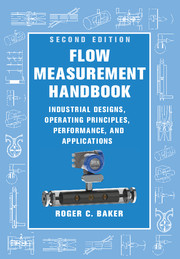Book contents
- Frontmatter
- Dedication
- Contents
- Preface
- Acknowledgements
- Nomenclature
- 1 Introduction
- 2 Fluid Mechanics Essentials
- 3 Specification, Selection and Audit
- 4 Calibration
- 5 Orifice Plate Meters
- 6 Venturi Meter and Standard Nozzles
- 7 Critical Flow Venturi Nozzle
- 8 Other Momentum-Sensing Meters
- 9 Positive Displacement Flowmeters
- 10 Turbine and Related Flowmeters
- 11 Vortex Shedding, Swirl and Fluidic Flowmeters
- 12 Electromagnetic Flowmeters
- 13 Magnetic Resonance Flowmeters
- 14 Ultrasonic Flowmeters
- 15 Acoustic and Sonar Flowmeters
- 16 Mass Flow Measurement Using Multiple Sensors for Single-Phase Flows
- 17 Multiphase Flowmeters 508
- 18 Thermal Flowmeters
- 19 Angular Momentum Devices
- 20 Coriolis Flowmeters
- 21 Probes for Local Velocity Measurement in Liquids and Gases
- 22 Verification and In Situ Methods for Checking Calibration
- 23 Remote Data Access Systems
- 24 Final Considerations
- References
- Main Index
- Flowmeter Index
- Flowmeter Application Index
22 - Verification and In Situ Methods for Checking Calibration
Published online by Cambridge University Press: 05 August 2016
- Frontmatter
- Dedication
- Contents
- Preface
- Acknowledgements
- Nomenclature
- 1 Introduction
- 2 Fluid Mechanics Essentials
- 3 Specification, Selection and Audit
- 4 Calibration
- 5 Orifice Plate Meters
- 6 Venturi Meter and Standard Nozzles
- 7 Critical Flow Venturi Nozzle
- 8 Other Momentum-Sensing Meters
- 9 Positive Displacement Flowmeters
- 10 Turbine and Related Flowmeters
- 11 Vortex Shedding, Swirl and Fluidic Flowmeters
- 12 Electromagnetic Flowmeters
- 13 Magnetic Resonance Flowmeters
- 14 Ultrasonic Flowmeters
- 15 Acoustic and Sonar Flowmeters
- 16 Mass Flow Measurement Using Multiple Sensors for Single-Phase Flows
- 17 Multiphase Flowmeters 508
- 18 Thermal Flowmeters
- 19 Angular Momentum Devices
- 20 Coriolis Flowmeters
- 21 Probes for Local Velocity Measurement in Liquids and Gases
- 22 Verification and In Situ Methods for Checking Calibration
- 23 Remote Data Access Systems
- 24 Final Considerations
- References
- Main Index
- Flowmeter Index
- Flowmeter Application Index
Summary
Introduction
Checking calibration is increasingly important and possibly mandatory. To achieve this there are, at least, four possible approaches:
1. remove meter and recalibrate on a certified test stand;
2. in situ calibration as discussed in Chapter 4. To obtain the required uncertainty, this may mean comparing the meter with a transfer standard in series with it in the line. This would require that installations of such a meter would be possible so as to check calibration (Chapter 4). But there may be major problems in so doing and limitations to the safety and accuracy of the process;
3. use a clamp-on meter as transfer standard. This is an attractive option but, as indicated in Chapters 14 and 15, may not allow the level of uncertainty needed for many modern flowmeters;
4. implement verification procedures.We shall review verification and then look at other possibilities.
Verification
This is, essentially, condition monitoring applied in a very precise manner to flowmeters. The procedure is, increasingly, a continuous one, which can trigger well-focussed maintenance.
It should be remembered that differential pressure devices, such as orifice meters with removable plates (Figure 5.16), have a form of in situ verification.
Probably the first modern meter to introduce an early version, simulation, was the electromagnetic flowmeter (EMFM). A signal simulating the flow signal was introduced at the electrodes and the ability of the amplifier to measure it correctly was checked. The idea of simulation possibly stemmed from the simplicity of Equation (12.2) and the sense that, if the performance of the amplifier which measures the induced voltage could be checked and the magnetic field measured, the meter's operation would be confirmed.
The pressure to achieve in situ calibration has caused flowmeter companies to develop simulation techniques and to extend them to all the modern types of flowmeter. The effect of this has been to explore the extent to which the new devices can be used as an interim verification between calibrations, allowing the period between calibration to be extended by testing and verifying all the major functions of flowmeters on site.
- Type
- Chapter
- Information
- Flow Measurement HandbookIndustrial Designs, Operating Principles, Performance, and Applications, pp. 617 - 624Publisher: Cambridge University PressPrint publication year: 2016



